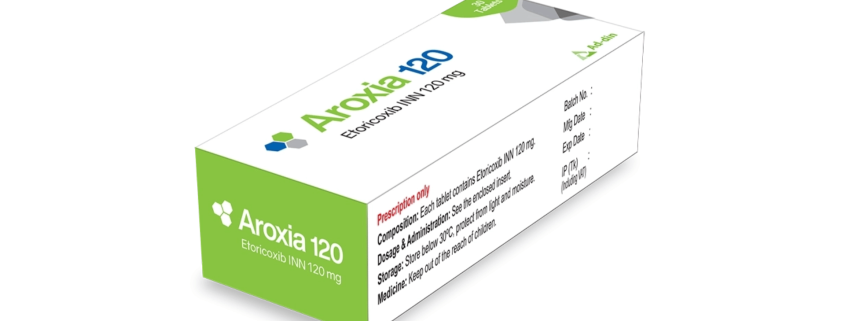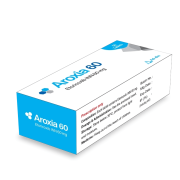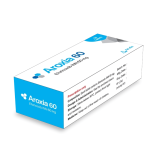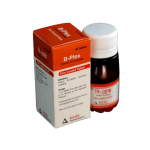Aroxia Tablet
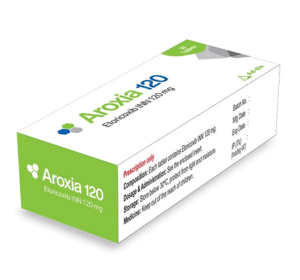
Etoricoxib
Indications
Aroxia is indicated for the symptomatic relief of-
- Osteoarthritis (OA)
- Rheumatoid arthritis (RA)
- Ankylosing spondylitis, and
- The pain and signs of inflammation associated with acute gouty arthritis.
- For the short-term treatment of moderate pain associated with dental surgery.
Pharmacology
Etoricoxib is a potent, orally active cyclooxygenase-2 (COX-2) specific inhibitor within, and significantly above, the clinical dose range. Two isoforms of cyclooxygenase have been identified: cyclooxygenase-1 (COX-1) and cyclooxygenase-2 (COX-2). COX-1 is responsible for prostaglandin-mediated normal physiologic functions such as gastric cytoprotection and platelet aggregation. Inhibition of COX-1 by nonselective NSAIDs has been associated with gastric damage and inhibition of platelet aggregation. COX-2 has been shown to be primarily responsible for the synthesis of prostanoid mediators of pain, inflammation, and fever. Selective inhibition of COX-2 by etoricoxib (within the clinical dose range) decreases these clinical signs and symptoms with decreased potential for Gl toxicity and effects on platelet aggregation. Etoricoxib produced dose-dependent inhibition of COX-2 without inhibition of COX-1 at doses up to 150 mg daily. Etoricoxib did not inhibit gastric prostaglandin synthesis.
Dosage & Administration
Adult and adolescent over 16 years:
- Osteoarthritis: The recommended dose is 30 mg once daily. In some patients with insufficient relief from symptoms, an increased dose of 60 mg once daily may increase efficacy.
- Rheumatoid arthritis: The recommended dose is 90 mg once daily.
- Ankylosing spondylitis: The recommended dose is 90 mg once daily.
- Acute gouty arthritis: The recommended dose is 120 mg once daily. In clinical trials for acute gouty arthritis, Etoricoxib was given for 8 days.
- Postoperative dental surgery pain: The recommended dose is 90 mg once daily, limited to a maximum of 3 days.
Some patients may require additional postoperative analgesia. As the cardiovascular risks of Etoricoxib may increase with dose and duration of exposure, the shortest duration possible and the lowest effective daily dose should be used. The patient’s need for symptomatic relief and response to therapy should be re-evaluated periodically, especially in patients with osteoarthritis.
Interaction
With medicine:
- Oral anticoagulants: In subjects stabilized on chronic warfarin therapy, the administration of Aroxia was associated with an increase in prothrombin time.
- Diuretics, ACE inhibitors and Angiotensin II Antagonists: NSAIDs may reduce the effect of diuretics and other antihypertensive drugs.
- Acetylsalicylic Acid: Aroxia can be used concomitantly with acetylsalicylic acid at doses used for cardiovascular prophylaxis (low-dose acetylsalicylic acid).
- Ciclosporin and tacrolimus: Although this interaction has not been studied with Aroxia, coadministration of ciclosporin or tacrolimus with any NSAID may increase the nephrotoxic effect of ciclosporin or tacrolimus.
- Lithium: NSAIDs decrease lithium renal excretion and therefore increase lithium plasma levels.
With food & others: Take without regards to meals.
Contraindications
- Hypersensitivity to the active substance or to any of the excipients.
- Active peptic ulceration or active gastro-intestinai (Gl) bleeding.
- Patients who have experienced bronchospasm, acute rhinitis, nasal polyps, angioneurotic oedema, urticaria, or allergic-type reactions after taking acetylsalicylic acid or NSAIDs including COX-2 (cyclooxygenase-2) inhibitors.
- Pregnancy and lactation.
- Severe hepatic dysfunction (serum albumin <25 g/l or Child-Pugh score 10).
- Estimated renal creatinine clearance <30 ml/min.
- Children and adolescents under 16 years of age.
- Inflammatory bowel disease.
- Congestive heart failure (NYHA ll-IV).
- Patients with hypertension whose blood pressure is persistently elevated above 140/90 mmHg and has not been adequately controlled.
- Established ischaemic heart disease, peripheral arterial disease, and/or cerebrovascular disease.
Side Effects
Side-effects may include palpitation, fatigue, influenza-like symptoms, ecchymosis; less commonly dry mouth, taste disturbance, mouth ulcer, appetite and weight change, atrial fibrillation, transient ischaemic attack, chest pain, flushing, cough, dyspnoea, epistaxis, anxiety, mental acuity impaired, paraesthesia, electrolyte disturbance, myalgia and arthralgia; very rarely confusion and hallucinations.
Pregnancy & Lactation
The use of Etoricoxib, as with any drug substance known to inhibit COX-2, is not recommended in women attempting to conceive. It is not known whether Etoricoxib is excreted in human milk. Etoricoxib is excreted in the milk of lactating rats. Women who use Etoricoxib must not breastfeed.
Precautions & Warnings
- Caution is advised with treatment of patients most at risk of developing a gastrointestinal complication with NSAIDs; the elderly, patients using any other NSAID or acetylsalicylic acid concomitantly or patients with a prior history of gastrointestinal disease, such as ulceration and Gl bleeding.
- Patients with significant risk factors for cardiovascular events (e.g. hypertension, hyperlipidaemia, diabetes mellitus, smoking) should only be treated with Aroxia after careful consideration.
- Administration of Aroxia may cause a reduction in prostaglandin formation and, secondarily, in renal blood flow, and thereby impair renal function. Monitoring of renal function in such patients should be considered.
- Caution should be exercised in patients with a history of cardiac failure, left ventricular dysfunction, or hypertension and in patients with pre-existing edema from any other reason.
- Any patients with symptoms and/or signs suggesting liver dysfunction, or in whom an abnormalliver function test has occurred, should be monitored. If signs of hepatic insufficiency occur, or if persistently abnormal liver function tests (three times the upper limit of normal) are detected, Aroxia should be discontinued.
- Aroxia should be discontinued at the first appearance of skin rash, mucosal lesions, or any other sign of hypersensitivity.
- Aroxia may mask fever and other signs of inflammation. Caution should be exercised when co-administering Aroxia with warfarin or other oral anticoagulants.
Overdose Effects
Administration of single doses of Aroxia up to 500 mg and multiple doses up to 150 mg/day for 21 days did not result in significant toxicity. In the event of overdose, it is reasonable to employ the usual supportive measures, e.g., remove unabsorbed material from the Gl tract, employ clinical monitoring, and institute supportive therapy, if required.
Therapeutic Class
Non-steroidal Anti-inflammatory Drugs (NSAIDs)
Storage Conditions
Store at a temperature of below 30°C, protect from light & moisture. Keep out of reach of children.
Chemical Structure
| Molecular Formula : | C18H15ClN2O2S |
| Chemical Structure : |
Common Questions about Aroxia 120 mg Tablet
What is Aroxia 120 mg Tablet?
Aroxia 120 mg Tablet is a selective COX-2 inhibitor. COX-2 has been shown to be primarily responsible for the synthesis of prostanoid mediators of pain, inflammation, and fever. Aroxia 120 mg Tablet produced dose-dependent inhibition of COX-2 without inhibition of COX-1 at doses up to 150 mg daily.
What are the uses of Aroxia 120 mg Tablet?
Aroxia 120 mg Tablet is indicated for the symptomatic relief of Osteoarthritis (OA), Rheumatoid arthritis (RA), Ankylosing spondylitis.
How long is the duration of effect of Aroxia 120 mg Tablet?
The effect of Aroxia 120 mg Tablet lasts for an average duration of 20-24 hours.
What is the onset of action of Aroxia 120 mg Tablet?
The effect of Aroxia 120 mg Tablet can be observed within 1-2 hours of administration. The onset is faster if the medicine is taken without food.
Are there any pregnancy warnings of Aroxia 120 mg Tablet?
Women who are pregnant should consult doctor before using Aroxia 120 mg Tablet.
Is it habit forming of Aroxia 120 mg Tablet?
No habit forming tendencies were reported.
Are there any breast-feeding warnings of Aroxia 120 mg Tablet?
Aroxia 120 mg Tablet is not recommended for use by mothers who are breastfeeding. It should be used only when the potential benefits outweigh the risks associated with usage. Consult your doctor before taking this medicine.
Is Aroxia 120 mg Tablet safe with alcohol?
Aroxia 120 mg Tablet is found to be unsafe to consume this medicine with alcohol.
Is Aroxia 120 mg Tablet safe to drive while on this medicine?
Aroxia 120 mg Tablet may affect alertness of the patient taking it. Thus patient must avoid driving.
Does Aroxia 120 mg Tablet affect kidney function?
Caution must be taken in patient with kidney disease. Adjustment of dose might be needed. Consult your doctor before taking Aroxia 120 mg Tablet. use of this medicine is strictly not recommended in patients with severe kidney disease.
Does Aroxia 120 mg Tablet affect liver function?
Caution must be taken in patient with liver disease. Adjustment of dose might be needed. Consult your doctor before taking Aroxia 120 mg Tablet. use of this medicine is strictly not recommended in patients with severe liver disease.
Quick Tips
- Aroxia 120 mg Tablet helps relieve pain and inflammation.
- Aroxia 120 mg Tablet may cause fewer stomach problems as compared to other NSAIDs like Ibuprofen or Naproxen.
- Aroxia 120 mg Tablet may cause dizziness and fatigue. Do not drive or do anything requiring concentration until you know how it affects you.
- Do not consume alcohol while on treatment with Aroxia 120 mg Tablet as it may cause excessive drowsiness.
- Regularly monitor your blood pressure while taking this medicine, particularly in the first two weeks after starting treatment.
- Inform your doctor if you have a history of stomach ulcers, heart diseases, high blood pressure, and liver or kidney disease.
- During long-term treatment, your doctor may want to take regular blood tests to monitor your liver function.
- Do not take Aroxia 120 mg Tablet if you are pregnant, planning to conceive, or breastfeeding.

